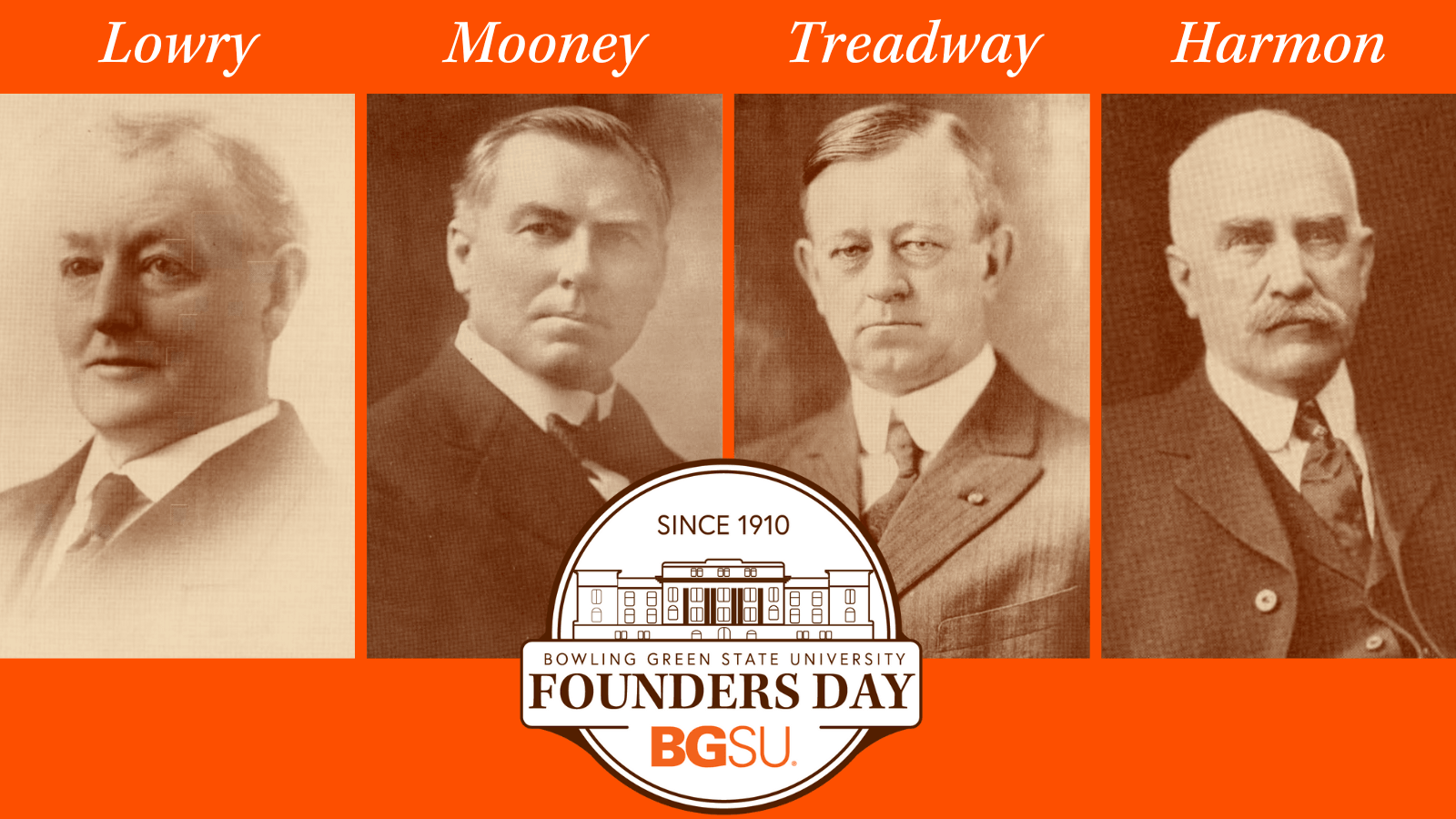
Honoring the visionaries: 4 BGSU founders shaped Ohio's educational landscape
Estimated Reading Time:
Learn more about the pioneers behind the humble beginnings of Bowling Green State University
Editor's note: The following is largely excerpted from the September 1956 edition of Bowling Green State University Magazine, which featured an in-depth look at the four men credited as BGSU founders as the University celebrated the construction of the new Founders Quadrangle residence hall.
In the early 1900s, Ohio legislators sought to expand the number of teacher-training institutions due to a need for more and better-trained teachers while also needing more clearly defined standards that would require a certain amount of college education for teachers. By 1910, Bowling Green State University - then Bowling Green State Normal College - was founded to serve that purpose.
Four people were instrumental in the creation of another teacher training institution in Ohio, leading to the founding of BGSU – John Hamilton Lowry, Granville W. Mooney, Francis W. Treadway and Gov. Judson Harmon.
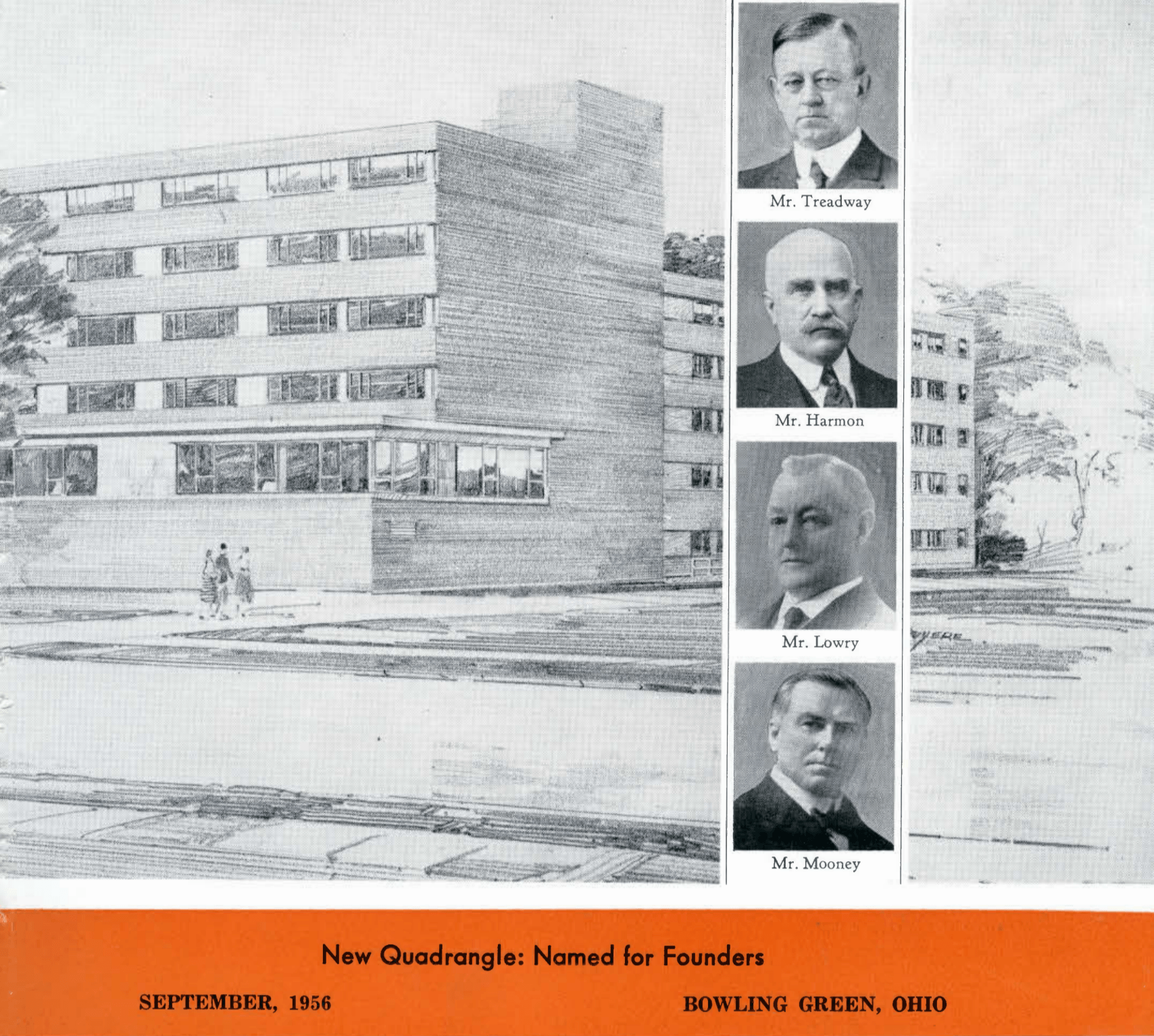
BGSU Founders Profiles
The Founders Quadrangle building, constructed in 1956, was named for the people who were instrumental in the legislative founding of the University. The four separate yet connected halls - Lowry Hall, Mooney Hall, Treadway Hall and Harmon Hall - were named for those who played major roles:
- John Hamilton Lowry, who sponsored the bill in the Ohio General Assembly in 1910
- Granville W. Mooney, speaker of the Ohio House of Representatives at that time
- Francis W. Treadway, president of the Ohio Senate
- Gov. Judson Harmon, who signed the legislation that created what became BGSU
The men instrumental in the founding of BGSU as a teacher-training institution in 1910 probably never dreamed that 113 years later the modest institution they helped establish would have become an important university, with greatly expanded faculty ranks, facilities and curriculum, research to aid all aspects of the public good and an investment in student success services to meet the needs of a rapidly growing and changing society.
Those men were concerned with the immediate problems of the need for more and better-educated teachers for Ohio’s youth, but in their efforts to solve those problems, they built better than they knew. Whether they were aware of it or not, they founded an institution that held promises of much progress and advancement in the field of higher education.
In their lives, these were men of considerable stature. Two were Republicans (Mooney and Treadway); two were Democrats (Lowry and Harmon). All had a college education. All were men of the highest ideals and ability. The four included a farmer from northwestern Ohio (Lowry), a teacher from northeastern Ohio (Mooney), a lawyer with business and philanthropic interests from Cleveland (Treadway), and an attorney from southeastern Ohio (Harmon). Three of them had taught school, and all were interested in public education and the general welfare.
That the four founders had the opportunity to work together on constructive legislation for the benefit of the state may have been the result of a happy circumstance, but it did happen, and with the result that their contribution to the growth and development of higher education in Ohio has been great and promises to continue to grow in the years to come.
John Hamilton Lowry
Among the people of Ohio who saw the educational situation clearly was John Hamilton Lowry, a teacher and farmer in Henry County. As a youngster, Lowry had gone through the common school in the nearby village of Florida, graduated from Napoleon High School, later attended Hillsdale College in Michigan and taught school for a few years.
Lowry was a descendant of one of the pioneer families of Henry County. His home near the village of Florida was in possession of the Lowry family for four generations, over a period of more than 100 years. Lowry’s grandmother was a member of the McKinley family and a relative of President McKinley.
Deeply interested in public education in Ohio, Lowry was determined to do what he could to improve the schools. An opportunity to use his influence on a statewide basis came in his election as a representative from Henry County to the Ohio General Assembly in the fall of 1908. So successful was Lowry in drafting and promoting a new school law in the three terms he served as representative from 1909 to 1914 that he became known in those years as “the father of school legislation.”
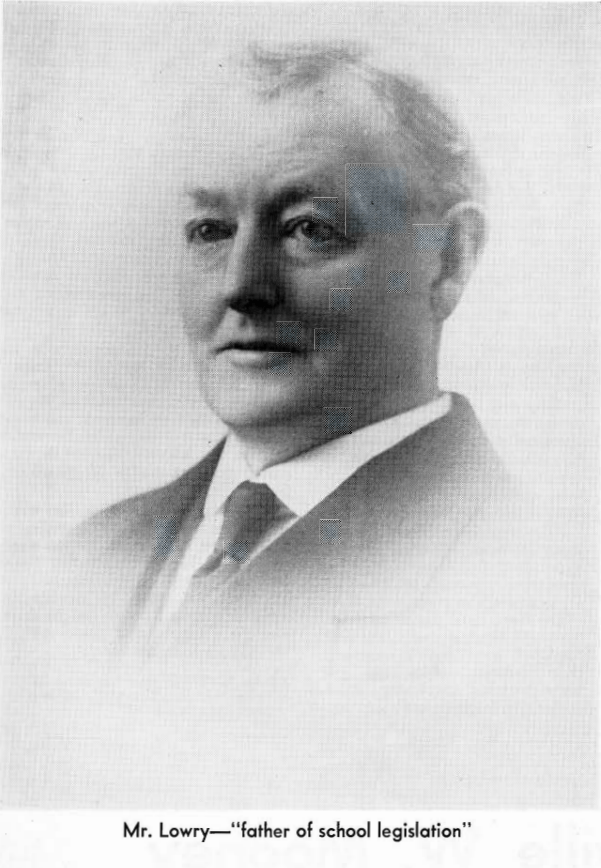
The first step in solving the major problems confronting public education in the state was, as Lowry saw it, for the government of Ohio to provide additional means for training teachers. Since there were no state-supported teacher-training institutions north of Columbus, Lowry believed that two more normal schools should be established - one in northeastern Ohio and one in northwestern Ohio.
Lowry was successful in initiating and obtaining the passage in 1910 of legislation to establish two additional teacher training institutions and later he had the opportunity to support legislation that set up more definite standards for common schools as well as legislation that required that a teacher have some college training in order to be granted a life teaching certificate.
His interest in education may perhaps have been all the more keen because there were several teachers in his family. He had taught school himself, his second wife had taught school, his daughter Helen became a teacher, and one of his daughters-in-law had been a teacher. All of his children completed high school and Helen attended college.
Lowry's 1910 bill is responsible for the establishment of the institutions now known as Bowling Green State University and Kent State University.
Granville W. Mooney
Granville W. Mooney, speaker of the Ohio House of Representatives from 1909 to 1910, was born in Ripley, Ohio, the eldest of three children of Thomas Williamson Mooney and Belle Farnsworth Mooney. His mother was a graduate of Grand River Institute in Austinburg and had taught school before her marriage.
She and her husband decided while their oldest son was still very young that they would move to Austinburg to live so their children might have the advantage of an education at Grand River Institute.
After graduating from Grand River Institute, Mooney went on to Oberlin College from which he graduated in 1895. He had to work his way through college because his parents were not able to pay all of his expenses. After graduation, he helped his younger brother and sister in obtaining their college educations.
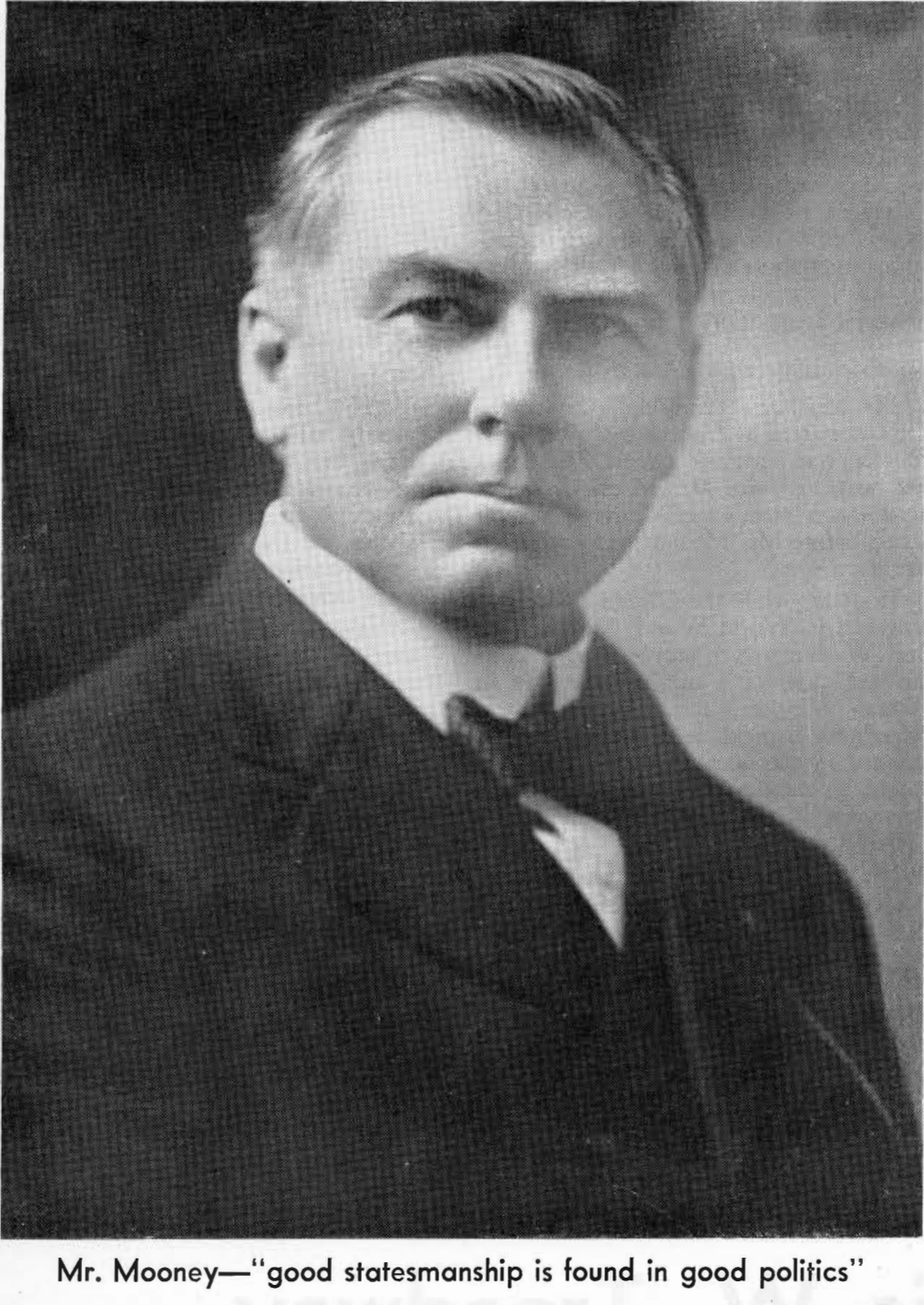
Not only did Mooney graduate from Grand River Institute, he became a teacher there, and from 1897 to 1904 was principal of the school. Mooney was an excellent teacher according to those who knew him. His vast store of knowledge on a wide range of subjects was said to be almost astonishing.
In 1908, Mooney decided to become a candidate for a representative to the Ohio General Assembly. He was elected in the fall of 1908 on the Republican ticket to represent Ashtabula County in the 78th session of the Ohio General Assembly from 1909 to 1910.
Although serving his first and only term as representative, he was elected speaker of the house for this session. It was here that he had an opportunity to aid public education in Ohio by assisting the passage of House Bill No. 44, which created two new normal schools and other legislation designed to aid the schools of the state. His signature as speaker of the house appears on these progressive legislative acts.
It is said that in all aspects of his life, Mooney displayed the finest type of character and citizenship. The caliber of the man and the ideals by which he lived are reflected in his address as speaker of the House of Representatives of the Ohio General Assembly at the opening of the 78th session. Among his remarks was the comment that, “Bills ought to be considered on their merit regardless of personal prejudice or political bias. In the end, good statesmanship will be found in good politics.”
Francis W. Treadway
Francis Treadway was lieutenant governor and president of the Ohio Senate from 1909 to 1910. He was born in New Haven, Connecticut, as the second-oldest child in a family of four children. He spent most of his life in Cleveland, moving to the city with his parents when he was 10 years old.
Treadway obtained his education at Worcestor Polytechnic Institute in Massachusetts and at Yale University, from which he graduated in 1892. One of the outstanding members of his class, he was awarded the Munson Prize at graduation for his thesis. At Yale, he also was a member of Phi Delta Phi fraternity. Treadway was admitted to the Ohio Bar Association in 1892 and he established the law firm of Treadway and Marlatt in Cleveland, which became widely and favorably known in Ohio legal circles.
In the course of his legal career, Treadway became interested in the affairs of government. According to “American Biography,” for a long period he was a major factor in Republican political activities. Treadway served as United States commissioner from 1902 to 1903 and as a representative to the Ohio General Assembly from 1903 to 1904. In 1907, he turned his attention to local politics and was nominated for the office of vice mayor of Cleveland but was defeated in the election.
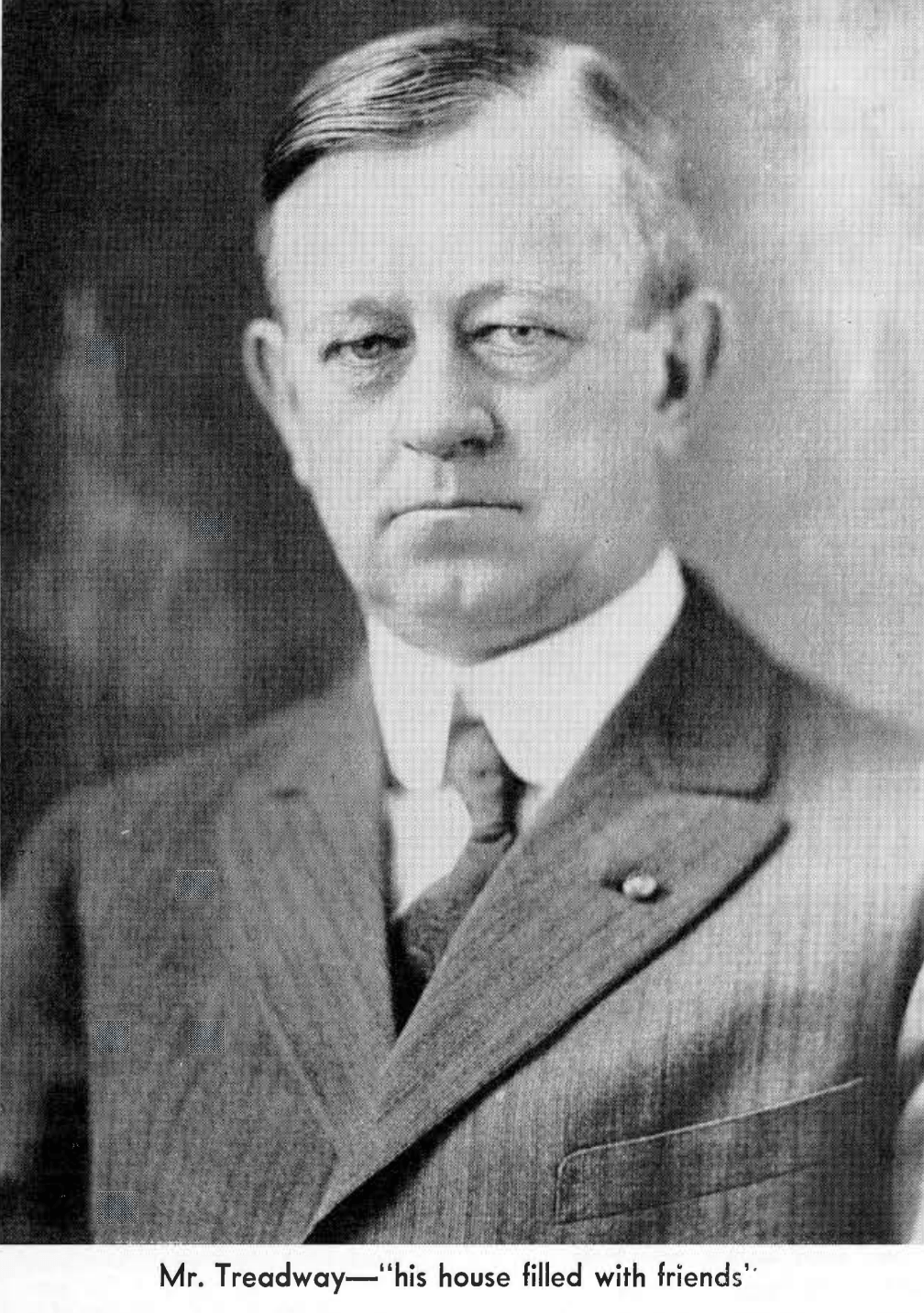
In the fall of 1908, he again was a candidate, this time for the office of lieutenant governor of Ohio, and was elected. It was in this capacity that he became one of the men who was instrumental in securing the passage of House Bill No. 44 that, when enacted in 1910, established the two new teacher-training institutions in Ohio that eventually became known as Bowling Green State University and Kent State University.
At this point in his career at age 41, Treadway faced a decision — whether to continue in politics or to devote his time to his law practice and many business interests that needed his attention. He decided in favor of the latter. Treadway became one of the leading businessmen and civic members of Cleveland, and it was said that “his civic spirit was pronounced and contagious, and his influence he exerted for the common good of the community.”
Gov. Judson Harmon
Gov. Judson Harmon was governor of the state of Ohio from 1909 to 1913 and historians have deemed him “one of Ohio's greatest governors.” Harmon was born in Hamilton County, Ohio, as the eldest son in a family of eight children. His father, Benjamin Franklin Harmon, came to Ohio in 1840 as a schoolteacher. At the age of 16, Judson Harmon entered Denison University in Granville, Ohio, and worked his way through college, graduating with a bachelor of arts degree at the age of 20.
After he had become governor, he was asked if he had had any particular ambition early in life. He replied, “No, not until I went to Granville; and then I wished to become a good lawyer so that I could make an independent living. I had no money nor any particular prospects, and I knew I must work hard to help myself.”
After graduating from Denison University, Harmon taught school in Licking County and later became a principal at a school in the suburbs of Cincinnati. The next year he began reading law in the office of Gen. Joshua H. Bates and studying law at the Cincinnati Law School, where he graduated with a bachelor of law in 1869. A year after graduating from law school and being admitted to the bar, Harmon married Olivia Scobey of Hamilton, Ohio, and the couple had three daughters.
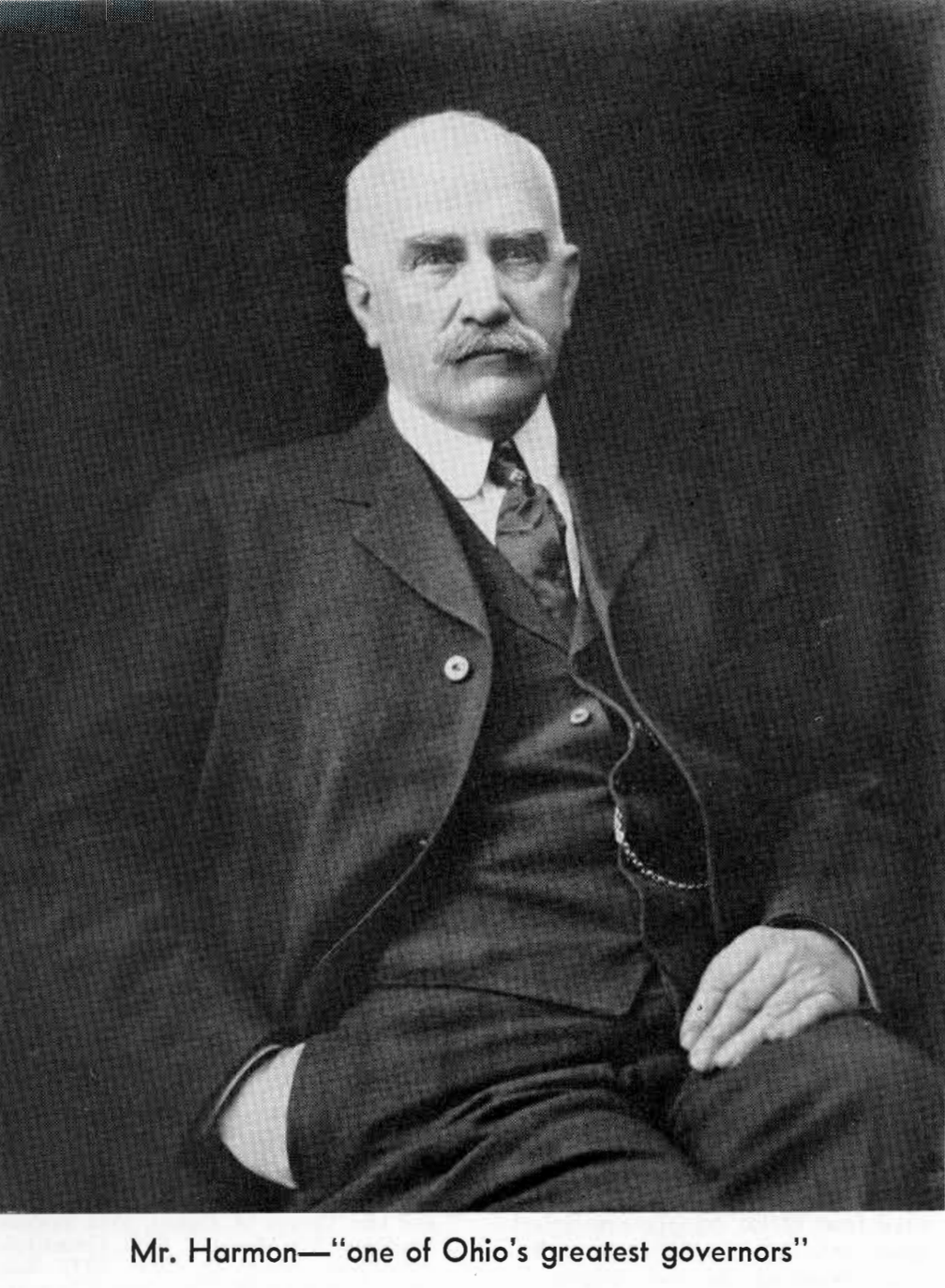
Four years after his marriage, Harmon was elected mayor of Wyoming, Ohio, and served in that office from 1875-76. In 1876, he was elected judge of the Common Pleas Court of Hamilton County and in 1878 was elected judge of the Superior Court of Cincinnati. He served in that position until 1887 when he resigned to take the place of Governor Hoadley in the law firm of Hoadley, Johnson and Colston, which eventually became Harmon, Colston, Goldsmith and Hoadley.
After becoming widely known and celebrated for his skills as an attorney, Harmon was appointed by President Grover Cleveland as U.S. attorney general on June 8, 1895. He served in this cabinet post until March 5, 1897. Harmon continued to gain stature as an attorney in private practice after his experience as a member of President Cleveland's cabinet.
Harmon was not an active candidate for the governor's office in Ohio in 1908, but political leaders felt that he was the best possible candidate to wrest control from the Republican Party. As a result, Harmon was nominated at the convention in Columbus on May 5. The election that fall proved the political leaders of the Democratic Party both right and wrong. They were right in their belief that Harmon could be elected governor, but they were wrong in believing his name could swing the entire ticket. The only other Democrat elected on the state ticket was David S. Creamer as treasurer.
The faith the Democratic leaders had placed in Harmon, however, was justified two years later in the election of 1910. He was nominated without opposition at the convention in Dayton that spring. Opposing him for governor on the Republican ticket was Warren G. Harding, who was later to become president of the United States. Also nominated on the Republican ticket that year were Francis Treadway for lieutenant governor and Granville Mooney for secretary of state. Democrats made a clean sweep of the election that fall.
Harmon was unquestionably interested in education throughout his life. He began his career as a teacher, and in 1896, he became a professor of constitutional law at his alma mater, the Cincinnati Law School, and served in that capacity on a part-time basis for many years. His chief interests, however, were law and government. Important school legislation relied on Harmon’s support during his two terms as governor, including the bill that created what would become Bowling Green State University and Kent State University.
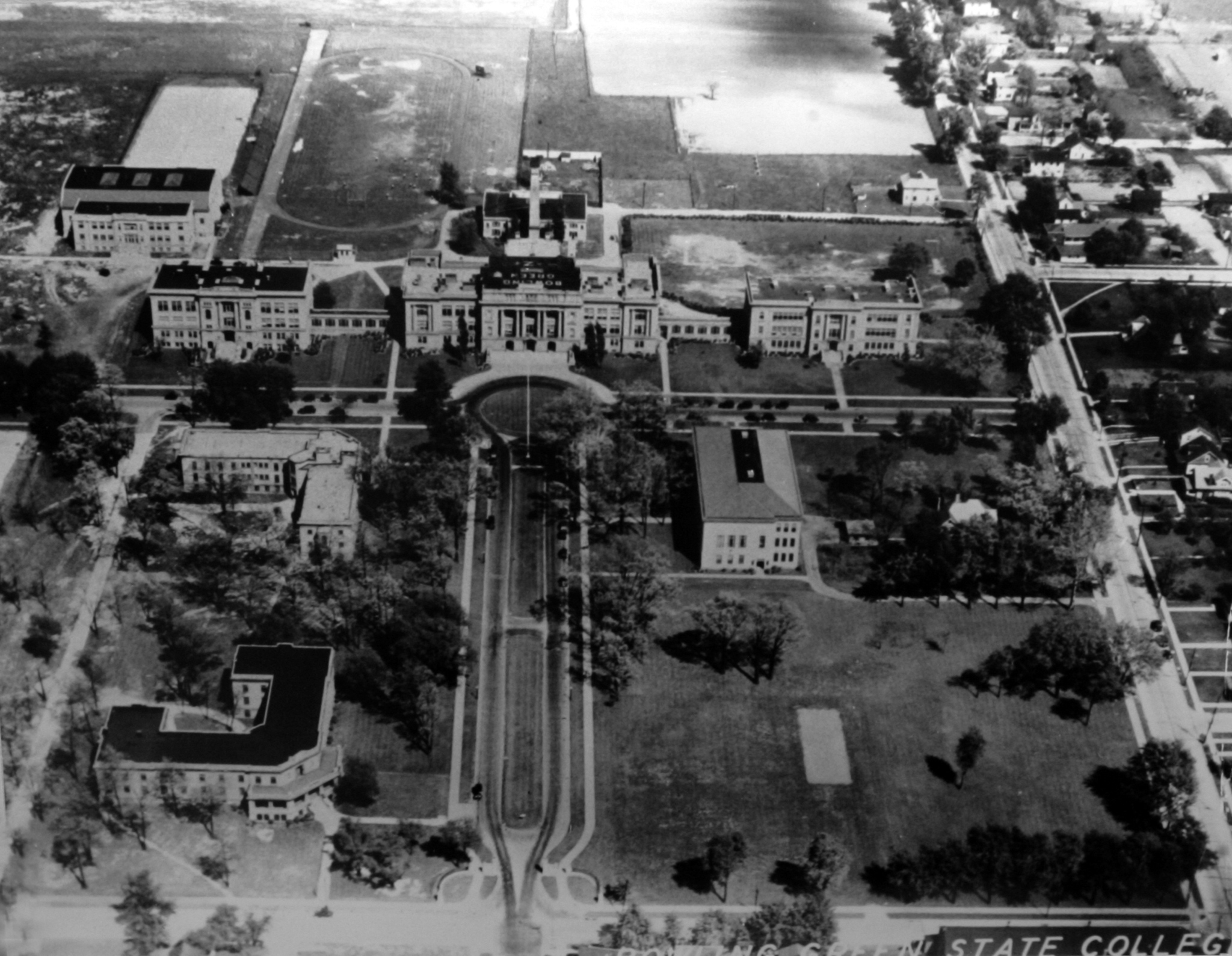
It is doubtful that any of the men whom BGSU now honors as founders fully realized the implications and the far-reaching effects of the school legislation on which they cooperated. The scene was simply too close to provide full perspective and to reveal completely the inherent promises it held for the future. Most probably looked upon their work as one of the many tasks to be accomplished in the building of a better Ohio. In that sense, their achievements present a challenge and their memory an inspiration for all.
Related Stories
Media Contact | Michael Bratton | mbratto@bgsu.edu | 419-372-6349
Updated: 09/28/2023 08:50AM




